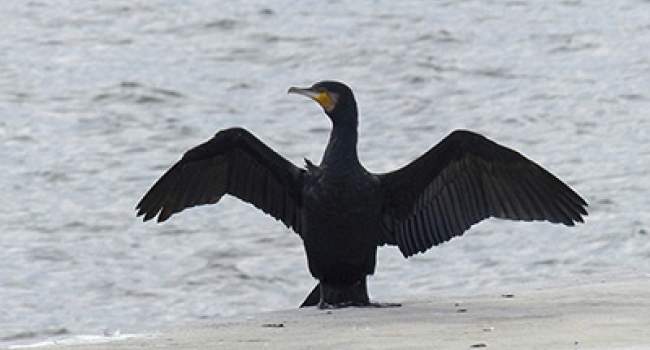Shag
Gulosus aristotelis (Linnaeus, 1761)
SA
 SHAG.
SHAG.  800
800

Family: Suliformes > Phalacrocoracidae

The Shag is very much a coastal bird, breeding exclusively around our rocky shores during the summer months and not moving very far during the winter.
It’s long thin bill, peaked forehead and small yellow gape set it apart from its close cousin the Cormorant. Shags can be seen in large feeding flocks, sometimes numbering in the hundreds, when birds at the back of the group will take off and fly to the front, the whole flock moving in this way as they catch the small fish that make up their diet.
Shags nest in loose colonies and there have been several studies of these – ringing data show that this is quite a long-lived species.
Identification
Shag identification is often straightforward. The following article may help when identifying Shag.
Identifying Cormorant and Shag

A black, reptilian-looking bird swims by low to the water - but is it a Cormorant or a Shag? Cormorants are more familiar and wide-spread, although Shags are more numerous. Let us help you to separate these two similar-looking species of water bird.
SONGS AND CALLS
Listen to example recordings of the main vocalisations of Shag, provided by xeno-canto contributors.
Call
Develop your bird ID skills with our training courses
Our interactive online courses are a great way to develop your bird identification skills, whether you're new to the hobby or a competent birder looking to hone your abilities.
Browse training coursesStatus and Trends
Population size and trends and patterns of distribution based on BTO surveys and atlases with data collected by BTO volunteers.
CONSERVATION STATUS
This species can be found on the following statutory and conservation listings and schedules.
POPULATION CHANGE
The Shag is found almost exclusively in marine habitats where it is restricted to inshore waters. It is found around much of the coast of the UK where cliffs are available but is largely absent from south and east England where there is no suitable nesting habitat. Data from censuses indicate that numbers increased by around 21% between 1969–70 and 1985–88 but dropped by around 27% between 1985–88 and Seabird 2000 (1998–2002). Results from the more recent Seabird Count (2015–2021) are not yet available, but data from annual monitoring suggest that there has been a further decline since Seabird 2000 and hence the population is believed to be well below the level in 1969–70 (JNCC 2022).
DISTRIBUTION
Shags are recorded around much of the coast of Britain & Ireland in winter, with the highest densities in northern and western Scotland and western Ireland. Breeding colonies are found on many northern and western coastlines with suitable cliffs.
Occupied 10-km squares in UK
| No. occupied in breeding season | 498 |
| % occupied in breeding season | 16 |
| No. occupied in winter | 948 |
| % occupied in winter | 31 |
European Distribution Map
DISTRIBUTION CHANGE
Marked population declines have not yet resulted in significant range loss: there has been only a 9% range contraction in Britain & Ireland since the 1968–72 Breeding Atlas.
Change in occupied 10-km squares in the UK
| % change in range in breeding season (1968–72 to 2008–11) | -7.2% |
| % change in range in winter (1981–84 to 2007–11) | +11.7% |
SEASONALITY
Shags are recorded throughout the year at suitable coastal locations.

Movement
Information about movement and migration based on online bird portals (e.g. BirdTrack), Ringing schemes and tracking studies.
RINGING RECOVERIES
View a summary of recoveries in the Online Ringing Report.
Foreign locations of birds ringed or recovered in Britain & Ireland

Biology
Lifecycle and body size information about Shag, including statistics on nesting, eggs and lifespan based on BTO ringing and nest recording data.
SURVIVAL & LONGEVITY
View number ringed each year in the Online Ringing Report
Maximum Age from Ringing 
|
29 years 10 months 25 days (set in 2007) 
|
Typical Lifespan 
|
12 years with breeding typically at 4 year |
Adult Survival 
|
0.878±0.001  
|
Juvenile Survival 
|
0.38 (to age 2) 
|
CODES & CLASSIFICATION
Ring size 
|
K |
Field Codes 
|
2-letter: SA | 5-letter code: SHAG. | Euring: 800 |
For information in another language (where available) click on a linked name
Research
Interpretation and scientific publications about Shag from BTO scientists.
CAUSES AND SOLUTIONS
Causes of change
The increase in the reported population between 1969–70 and 1985–88 may partly reflect better coverage of colonies which are difficult to access, but increased legal protection and reduced persecution may also have contributed (JNCC 2022). The annual monitoring data indicate that mass mortality during prolonged periods of severe weather in some winters strongly affects breeding abundance (Harris & Wanless 1996), and increased frequency of such events due to climate change may potentially be driving population declines. Analysis of year-round diet between 1985 and 2014 suggests that reductions in sandeel abundance have also resulted in diet changes throughout the year and hence changes in sandeel abundance (and abundance of other prey species) could potentially also have an impact on the population through survival (Howells et al. 2018).
Links to more studies from ConservationEvidence.com
- Seabird mortality at trawler warp cables and a proposed mitigation measure: a case of study in Golfo San Jorge, Patagonia, Argentina
- The effectiveness of different methods to deter large gulls Larus spp. from competing with nesting terns Sterna spp. on Coquet Island RSPB reserve, Northumberland, England
- Drivers of seabird population recovery on New Zealand islands after predator eradication
Would you like to search for another species?












Share this page